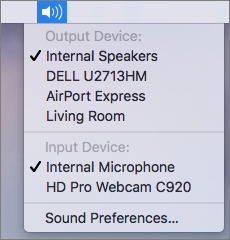

- #Soundsource alternative mac how to#
- #Soundsource alternative mac mac os#
- #Soundsource alternative mac install#
- #Soundsource alternative mac software#
- #Soundsource alternative mac professional#
#Soundsource alternative mac install#
> Download Osx Uninstaller, install it on your Mac, and click to launch this tool.
#Soundsource alternative mac how to#
Video: How to easily & thoroughly uninstall SoundSource (or other Mac apps) To completely uninstall SoundSource and remove its vestiges, you just need to do 3 simple steps: launch > select > uninstall. Here we would like to recommend Osx Uninstaller, a lightweight yet powerful app designed for all level users to perfectly remove problematic, stubborn or malicious apps.
#Soundsource alternative mac professional#
If you do not want to dig down the system for removing SoundSource, you can turn to a professional uninstall tool to accomplish the task effortlessly. There are many Mac utilities that claim to help hunt down all application files and delete them for you. Perfectly Uninstall SoundSource within Simple Clicks (3) Launch the Activity Monitor from Dock, Launchpad or Spotlight > type SoundSource in the search box > select the process pertaining to SoundSource > click the “X” button on the upper left corner > click Quite in the pop-up dialog (if that fails, choose Force Quite).Īfter that you can carry out a clean uninstall either automatically or manually.(2)ěring SoundSource to the desktop, and choose Quit option from the Apple menu.(1) Right click on its icon on the Dock, and choose the Quit option.There are several options for you to exit out of SoundSource: Before you start the uninstallation, you are supposed to quite the app if it is running, otherwise the uninstall may fail or trigger error message. What should you do before uninstalling SoundSource:įirst of all, don’t rush to drag SoundSource to the Trash.
#Soundsource alternative mac mac os#
Struggling to uninstall unneeded applications from your Mac computer? Having trouble in removing the entire application components around the system? This tutorial will show you how to effectively uninstall SoundSource in macOS or Mac OS X. Once you do not want to keep an app on your Mac, you can uninstall SoundSource by multiple methods. You can get an app from Mac’s App Store, discs or other websites, and then install it by dragging the app icon to the Applications folder or running the provided installer in the disk image or package file.
#Soundsource alternative mac software#
If I had to choose between upgrading my Mac or continuing to use Audio Hijack, I would choose Audio Hijack every time 1.There are various kinds of software that you can install on your Mac, and it is quite easy to manage those apps on macOS. Surely there’s a way, at the very least, to pre-approve an extension before rebooting to adjust the security setting? I know that Apple is trying to protect users from bad actors, but when a list of instructions like these are required to install Mac software, something’s really gone wrong.īut at least Rogue Amoeba’s apps are now available. One reboot is bad, but two is ridiculous. It’s a multi-step process, but it’s over fast and then you can get on with your work.īut it really shouldn’t work this way, and that’s on Apple. The good news for Rogue Amoeba’s customers is that their stuff works, and once you do the reboot two-step, you shouldn’t need to do it again. (ACE isn’t actually a kernel extension, but… the box must still be checked.) Then you have to change a setting from “Full Security” to “Reduced Security,” and check a box allowing kernel extensions from identified developers. Before you can reboot to enable ACE, you first have to reboot into Recovery Mode in order to tell the system to allow extensions. On M1 Macs, though, the situation intensifies.

That’s not great-rebooting to install software feels very 1990s to me-but at least it’s palatable. To install an app like ACE, which requires a system extension to function in Big Sur, you have to reboot. There is one big caveat, however, and it’s all down to Apple’s increased focus on security. The company managed to get versions supporting Big Sur out just before the official release of the operating system, and today it posted beta versions that work with M1 Macs.

This year, though, Apple made some major changes to how audio on macOS is handled, and that required major changes to ACE, the engine that enables most of Rogue Amoeba’s apps. Loopback is a vital tool when I’m streaming video live. I love Rogue Amoeba’s audio apps and rely on them every day. Rogue Amoeba’s apps updated for M1–with a catch


 0 kommentar(er)
0 kommentar(er)
